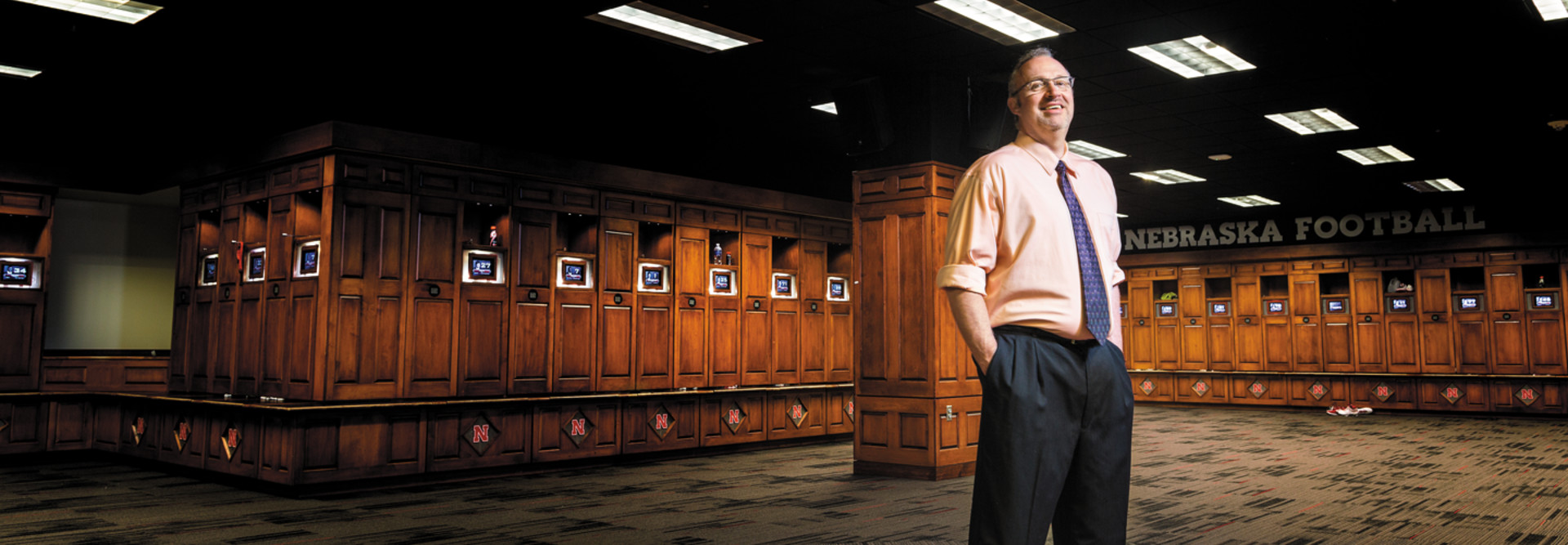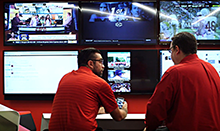University of Nebraska Cornhuskers Transform Fan Experience with Wi-Fi
On Oct. 20, 1962, University of Nebraska–Lincoln football fans filled 30,701 of Memorial Stadium’s 36,501 seats for a game against Kansas State. That was the last time a seat went empty for a Cornhuskers game. The team has enjoyed a famed sell-out streak ever since, filling the facility, which now accommodates more than 85,000, with a sea of red for the past 340 games.
The Huskers happen to be in the minority: Throughout the nation, ticket sales for even the biggest names in college football are on the decline. With the broad accessibility of big-screen, high-definition TVs, it’s a difficult sell to get fans to pay for tickets, brave traffic, search for parking and sit in a stadium where they can’t even get a wireless signal to check the scores of other games or tweet about a touchdown.
University of Nebraska officials don’t take their good fortune for granted. They regularly poll fans about their stadium experiences and seek ways to improve. So when they started hearing complaints about the speakers — that they were too loud in some sections and inaudible in others — and the lack of Wi-Fi for fans, they decided it was time to take their infrastructure to a new level.
Turn on the access
Last year, the Huskers enhanced their network infrastructure and installed Cisco Connected Stadium Wi-Fi and Cisco StadiumVision, which distributes HD video and digital content to TVs and digital signage throughout the facility. The university also implemented StadiumVision Mobile, to give fans access to high-definition content delivered straight to their smartphones or tablets.
“It’s about allowing the fans to experience the game the way they want to — having services that they’re used to having at home, because that’s really our competition,” says Dan Floyd, IT director for the University of Nebraska Athletic Department. “We’re competing with the home environment, where they’ve got Wi-Fi, they have TV, they can watch different games. Now we give them things that they can’t get at home, like video streams and downloads.”
GameDay Plan
Memorial Stadium embodies the phrase “old meets new.” One of the oldest stadiums in college football, it’s now also one of the most high-tech — college or pro — in the nation. Maintaining both honors can prove challenging.
In typical Wi-Fi installations, the access points are mounted on poles, but with no overhead infrastructure in Memorial Stadium’s north or south end zones, there was no easy solution for hanging APs. Team officials didn’t want to erect anything above the aerial view or disrupt the historic site.
“When you have a 1920s stadium, you’re not going to stick poles up everywhere, so there were some design considerations,” Floyd says. “In quite a bit of our stadium, you can still see the original structure, and we’re not going to mess with that.”
The project team — consisting of representatives from CDW, Cisco Systems and a local electrical company — came up with some creative solutions for getting around such issues, he says.
Upon completing a site survey, the team hung as many of the 800-plus APs as they could on the existing infrastructure; then, for added coverage, they installed p-rails — plastic enclosures for the APs — into the stadium’s handrails, says CDW Program Manager George Smedley Jr., one of a team of 10 CDW experts who worked on the stadium project. They also found other creative workarounds, such as mounting antennas on the sides of video boards.
Amount of data used in Memorial Stadium during the Huskers’ Sept. 20, 2014, game against the University of Miami
SOURCE: University of Nebraska Athletic Department
Game Changers
The stadium’s age also posed a challenge when it came to upgrading the network because the team had to drill through dense concrete to lay cables. “It’s real concrete,” Floyd says. “Not like what they make today. That was tough.”
The project team, which began work in April 2014, also installed Cisco’s StadiumVision and sound system infrastructure equipment. All told, they installed more than 800 digital media players and placed touch panels and surround sound systems in 101 suites.
Such projects can be complex, Smedley admits: Cabling is complicated inside any stadium and, inevitably, issues arise that are unique to each facility. It’s important to choose partners with experience working on major stadium projects.
University of Nebraska officials also appreciated the fact that Cisco has years of experience deploying high-density installations at professional venues. When the university started researching systems, four colleges offered Wi-Fi in their stadiums. Three used Cisco, and the fourth institution surveyed wasn’t happy with their solution. In fact, when one of the university’s consultants visited, the Wi-Fi was down through an entire game.
One of the greatest challenges in Memorial Stadium was ensuring 100 percent Wi-Fi and cellular coverage, and the only way to do that accurately was to fill stadium seats with people. CDW and Cisco representatives attended the first several games of the Huskers’ 2014 season to test the network, fanning out throughout the stadium, occupying people’s seats when they got up to use the restroom or get food, to validate signal strength, Smedley says.
The project team continued to fine-tune the network throughout the season, and Huskers staff interacted with fans to find out how it was working in different parts of the stadium. “We got a lot of feedback from social media,” Floyd says. “Fans were very excited about it.”
Floyd’s team didn’t advertise the Wi-Fi at the start of the season, which turned out to be a wise move. “We wanted people to find it and get on it gradually,” he says. “By the third game, we were confident that we had a good, strong baseline, and then we really started to push the Wi-Fi and smartphone app with fans.”
From Every Seat and the Sideline
Installation wasn’t easy, but it was more than worth the cost and effort, Floyd says.
“Wi-Fi in particular is just becoming a fan expectation,” he says. “You see Wi-Fi everywhere. Cities are installing it in various business districts, the NFL’s made it a priority to put it in all their stadiums, it’s in all the baseball stadiums. It’s a given. Fans expect it, and if you don’t offer those types of services, you’re going to lose fans.”
Wi-Fi use numbers last season support Floyd’s assessment: Memorial Stadium averaged more than 22,000 peak users throughout the season.
“That’s up there with the Dallas Cowboys and the San Francisco 49ers, which have the most high-tech stadiums in the country,” he says.
Before the upgrade, even cellular coverage in the stadium was spotty, especially for Verizon customers, who account for 75 percent of Lincoln’s market. Now that mobile users can connect to Wi-Fi, the cellular networks aren’t as congested, freeing up capacity for calls and texts within the facility.
Fans aren’t the only visitors who appreciate the 100 percent coverage.
“Internally, I think most of the folks love it,” Floyd says. Cafeteria employees use wireless devices to maintain inventory. Without coverage, they resorted to tracking items on paper, then later inputting information when they eventually walked somewhere with Wi-Fi coverage. The events crew often had to scan tickets offline.
“We don’t have those problems anymore,” Floyd says.
The expanded coverage has even helped the players prep for games. They use tablets to review the playbook, and can now access the network from the field, the locker rooms or the strength and conditioning center.
The expanded coverage also introduced new opportunities to interact directly with fans. Memorial Stadium’s Corn Crib — a spot where, during games, members of the media relations team communicate with the public via social media — has benefited as well.
Everyone’s a Winner
Above all, StadiumVision has proved simple to manage. Memorial Stadium is one of four major sports facilities used by the university. The nearby Pinnacle Bank Arena (PBA), which is owned by the city and used for men’s and women’s basketball, had already deployed Cisco StadiumVision and Connected Stadium Wi-Fi, so staff there were able to help Floyd and his team get started with their own new systems.
Because PBA and Memorial Stadium are on the same Wi-Fi network, members of the press need to register only once to cover sports at the different facilities. Before the installation, press at Memorial Stadium had to register their devices through UNL’s campus Wi-Fi, which was a more cumbersome process.
The StadiumVision solution has also been popular among fans and staff. The suites all have HD TVs as well as surround sound and touch-screen panels, which are easier to use than remote controls. “The picture quality is just out-of-this-world better,” Floyd adds, comparing the new IP television to the standard cable service they had before.
The entire system has positioned Memorial Stadium in line with professional stadiums, which will ultimately keep fans lining up outside its gates. “A big part of this was maintaining that sellout streak,” Floyd says, “and continuing to invest in and engage with our fans.”









